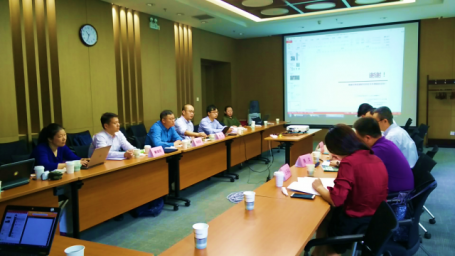Expert Review Session on Design Guideline on Safe Access to Public Transport Co-Hosted by WRI and CAUPD

The Design Guide on Safe Access to Public Transport (hereinafter referred to as the Guide), a project co-produced by the World Resources Institute (WRI) and China Academy of Urban Planning and Design (CAUPD), held its expert review session on May 14. ZHOU Le, Director of Transport Engineering Department of the Transport Institute of CAUPD, reported the findings from the project on behalf of the project team. WRI Sustainable Cities Program Director LIU Daizong, and senior associate Kim Beng Lua and team members listened to the report. The expert panel consisted of LI Wei, Director of the Planning Research Department of the Beijing Municipal Institute of City Planning and Design, LI Ruimin, associate professor at Tsinghua University, XIONG Wen, associate professor at Beijing University of Technology, WANG Dong, Deputy Director of Project Center of the Road Administration Bureau of Beijing Municipal Commission of Transport, and WANG Shuling, Deputy Director of the Rail Department of Beijing Transport Institute. The experts heard, commented on and discussed the outcome report.
The Design Guide on Safe Access to Public Transport is part of the global efforts to promote road safety in developing countries with the support from Bloomberg Philanthropies. “1.2 million people are killed by traffic crashes globally each year. China is one of the countries with large numbers of victims. Most of the crash victims are among vulnerable road users, including pedestrians, cyclists and bus riders, all of whom are sustainable travelers that the country is encouraging. Therefore we are discussing the safety of sustainable travel modes,” said LIU Daizong. Kim Lua introduced the background of the project, stressing the significance of road design to enhancing road safety. He said, “Well-designed roads can protect vulnerable road users and enhance the safety of the entire process of public transport travel. It is conducive to developing sustainable transport and improving social equity.”
Starting by analyzing safety problems near public transport stations, the Guide proposed road design recommendations in regard to bus stations and their accessibility, including crossing facilities, parking, road markings and signs. The Guide also offers recommendations on safety measures for road sections with serious conflicts, such as at bus stops where approaching and leaving buses are a risk for cyclists, and car parking near bus stops which could impede visibility. At the end of the Guide, a discussion is provided on institutional barriers that affect implementations of safe road design in China. Building an inter-agency coordination mechanism is necessary to address road safety problems.
ZHOU Le from CAUPD believes that the combination of CAUPD’s experience in road transport engineering and WRI’s global vision and research expertise in road safety ensures the rich outcomes of the project. External expert LI Wei spoke on behalf of the expert panel and affirmed the relevance of safe road design in today’s China and recognized the outcomes of the Guide.
Part of the research outcomes of the Guide has been included in the draft of National Standard on Walking and Cycling Facilities and will contribute to moving China’s road design towards a safer future.